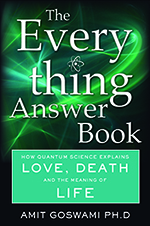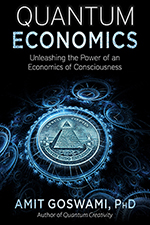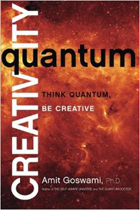What the Bleep Do We Know?
By Amit Goswami, Ph.D.
What the bleep do we know? A lot that the general public did not know, the 2004 movie by that name declared, and it gave us a glimpse of what that was. The movie did not answer, “Why the ignorance?” That wasn’t its job, but that is obvious because the academe and the news media were suppressing what was then the most upbeat news in our society. The movie was mind-opening because it showed the public that there is an alternative worldview of optimism; the public does not have to be torn between the two worldviews, each gloom and doom in its own way, battling in the news media: the liberal (supporting a scientific worldview called scientific materialism—matter is everything), and the conservative (advocating old-fashion feudalist and Christian values). The two worldviews are mutually exclusive, and the polarization between their supporters was already large and expanding. Twelve years later as of this writing, the polarization of worldviews is much larger. But things have changed as well. What the bleep do we know? The answer I’d give today is: a lot that the academe and the news media are still suppressing, but the public seems to be catching on—that a paradigm shift is occurring.
You probably know, I was in that movie, saying things like, “Quantum physics is the physics of possibilities,” and “consciousness is the ground of all being,” that caught the attention of the public. America became aware that there is a worldview in our midst, the Quantum Worldview, an integrative worldview to boot.
Those of us scientists that appeared in the movie were buoyed by the message of quantum physics. We were optimistic. We were not always agreeing with one another; fortunately, the viewers of the movie did not catch that; or if they did they ignored it. As new paradigm scientists, we still don’t agree a lot. But some of us did suspend our disagreements enough to write a couple of anthologies that could be called a post-materialist science. This was huge.
The other thing that is huge is applications. Even at the making of What the Bleep, applications, especially in the medical and psychology field were already quite big. You remember that movie expressed the optimism that even addictions can be permanently healed. Now we have Integrative Medicine universities, we have reliable diagnostic techniques for our subtle bodies (the vital, the mental, and the archetypal/spiritual). We even have a reliable theory of creativity that works for both body and mind healing. In India we are talking about establishing a University of Spiritual Transformation based on the quantum worldview. In Brazil, we have trained more than seven hundred quantum activists, who are busy trying to apply the new worldview not only to medicine in psychology but also in economics, business, and education. In the States, accordingly, we are building a Center for Quantum Economics Business Coaching.
What the Bleep do we know? The movie suggested via its main character Amanda that we run around in a materialist society in search of pleasure avoiding pain at all costs. There is no meaning in our lives, no purposive direction. But Amanda discovers quantum physics—the world is full of possibility, in that wonderful basketball scene. But of course, she could not put it to use, she could not make the right choice; she couldn’t put the basketball through the hoop.
There was still a ways to go; her little bottle of drugs fell from her hands while she was trying to catch a train. Although she managed to put most of the pills back in her bottle, she mashed one with her shoe in disgust. She was not ready yet. Then came the wedding party where she was the photographer. She got drunk, although she did feel the vacuity of her life, the vacuity of pursuing pleasure and avoiding pain, the vacuity of having no meaning and purpose.
In the morning, she woke up with a hangover. She looked in a mirror, and the gut wrenching words came out of her mouth, “I hate you.” Now she was ready, maybe!
She went out, and again encountered the basketball. This time, she took the basketball in her hands and chooses the healing facet of the possibilities offered; the basketball goes right through the hoop. And indeed, she is able to throw away her box of drugs.
Is this a realistic depiction of a quantum healing from drug addiction? The neurophysiology experts of the movie were saying in the background that the addiction was represented in the form of brain circuits in the hypothalamus, neurochemicals, and hormones. But can we change these physical circuits and physical molecules they emit? That would be like the early enthusiasts of quantum manifestation —we create our own reality, and that means my own Cadillac from scratch. But that does not work, does it?
Now we know how it may work. Let’s apply the quantum worldview to the neurophysiology of the brain. The brain circuits come with correlated vital blueprints (Sheldrake’s morphogenetic fields), and these correlated circuits further correlate with brain circuits of correlated mental meaning. All correlations are maintained non-locally via consciousness. In other words, an emotion is feeling plus meaning; the brain makes memories of both. And consciousness maintains the correlation of the stuff of the three different worlds of possibility.
We cannot change the physical part, the physical macro-reality has too much fixity, and it is almost Newtonian. But the correlated vital and mental parts are all quantum; they can be affected and changed by our conscious intentions.
Amanda experienced a mental intention and perhaps went through the creative process of mental creativity: receiving the mostly empty notebook to create the record of a new life for herself, feeling disgusted with her present, undirected meaningless life of pleasure. Her intention might be considered preparation. The long night’s sleep is when unconscious processing, the second stage of creativity took place. All the stuff in her brain and the associated mental and vital stuff along with new possibilities of the mind were processed by consciousness. The following morning, she took a quantum leap. Consciousness chose a new possibility in her mind, and her brain made a new memory, a brain circuit of it.
This creative event we call situational healing in the new integrative quantum science of healing. Does this do the job of ridding oneself from addiction? A little, yes. With her new mental circuit, she could say no to her negative emotion that was pushing her toward her addiction. However, when push comes to shove, when the negative emotions of life are too strong, too powerful, the response of the brain bypasses the neocortex entirely. So now the new mental circuit Amanda had created would not activate at all!
The people of Alcoholics Anonymous know this. Whenever such crisis occurs, the addict is advised to get external help. These people know that once you are an addict you are always an addict.
Or do they? The quantum worldview gives us another creative avenue for transformation, this time involving the archetypes—fundamental healing. The difference is this. A vital change is needed, and then only a vital brain circuit would be created which the brain cannot bypass. But perhaps, an addict is too weak, too unused to the creative process to engage the archetype of wholeness that includes the vital. Here a therapist can help. Taking advantage of our nonlocal interconnectedness, our consciousness, a therapist can add her creative acumen to the addict and help make the quantum leap. This would be an act of fundamental healing; when followed through the stage of manifestation, a vital-correlated brain circuit is created along with a mental one, and this does the trick. Even in the presence of strong negativity, the new circuits cannot be bypassed. I call such circuits brain circuits of positive emotion, but you have to take a quantum leap and look at the archetype anew. Only an archetype can be represented in both vital and mental and create brain circuits in both the mid-brain and the cortex.
This new understanding came about because recently I was invited to participate at a showing of What the Bleep in a theater in Puebla, Mexico. I made furious notes as the ideas were pouring forth in a state of flow. Afterwards, I gave a talk, and the audience seemed to like it. I hope you do too.



